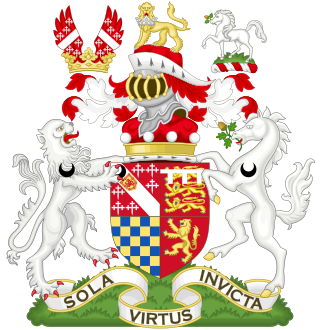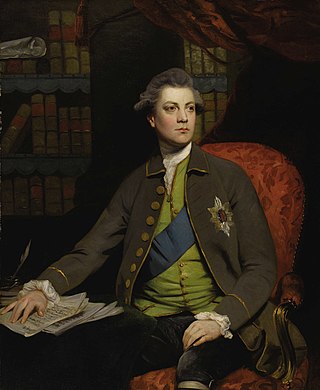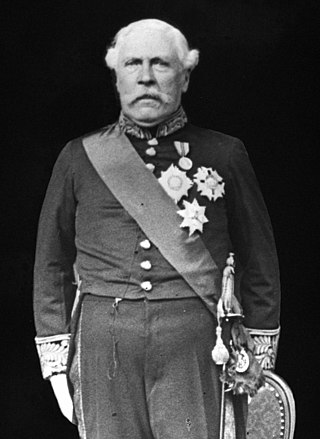
Earl of Suffolk is a title which has been created four times in the Peerage of England. The first creation, in tandem with the creation of the title of Earl of Norfolk, came before 1069 in favour of Ralph the Staller; but the title was forfeited by his heir, Ralph de Guader, in 1074. The second creation came in 1337 in favour of Robert de Ufford; the title became extinct on the death of his son, the second Earl, in 1382. The third creation came in 1385 in favour of Michael de la Pole. The fourth creation was in 1603 for Lord Thomas Howard, the second son of Thomas Howard, 4th Duke of Norfolk, by his second wife Margaret Audley, the daughter and eventual sole heiress of Thomas Audley, 1st Baron Audley of Walden, of Audley End in the parish of Saffron Walden in Essex. Howard was a prominent naval commander and politician and served as Earl Marshal, as Lord Chamberlain of the Household and as Lord High Treasurer. In 1597 he was summoned to Parliament as Baron Howard de Walden, and in 1603 he was further honoured, at the start of the reign of King James I, when he was created Earl of Suffolk. His second son the Hon. Thomas Howard was created Earl of Berkshire in 1626.

Earl of Lindsey is a title in the Peerage of England. It was created in 1626 for the 14th Baron Willoughby de Eresby. He was First Lord of the Admiralty from 1635 to 1636 and also established his claim in right of his mother to the hereditary office of Lord Great Chamberlain of England. Lord Lindsey fought on the Royalist side in the Civil War and was mortally wounded at the Battle of Edgehill on 23 October 1642. He was succeeded by his son, the second earl. He also fought at Edgehill and surrendered to the Parliamentarians in order to attend his mortally wounded father. Lord Lindsey later fought at the First Battle of Newbury, Second Battle of Newbury, and at Naseby. His son from his second marriage, James, was created Earl of Abingdon in 1682. He was succeeded by his son from his first marriage to Martha Cockayne, the third Earl. He represented Boston in the House of Commons and served as Lord Lieutenant of Lincolnshire.

Earl of Abingdon is a title in the Peerage of England. It was created on 30 November 1682 for James Bertie, 5th Baron Norreys of Rycote. He was the eldest son of Montagu Bertie, 2nd Earl of Lindsey by his second marriage to Bridget, 4th Baroness Norreys de Rycote, and the younger half-brother of Robert Bertie, 3rd Earl of Lindsey. His mother's family descended from Sir Henry Norris, who represented Berkshire and Oxfordshire in the House of Commons and served as Ambassador to France. In 1572 he was summoned by writ to Parliament as Lord Norreys de Rycote. He was succeeded by his grandson, the second Baron. In 1621, he created Viscount Thame and Earl of Berkshire in the Peerage of England. He had no sons and on his death in 1624 the viscountcy and earldom became extinct. He was succeeded in the barony by his daughter Elizabeth, the third holder of the title. On her death, the title passed to her daughter, the aforementioned Bridget, the fourth Baroness, and second wife of the second Earl of Lindsey.

Earl of Carlisle is a title that has been created three times in the Peerage of England.

Earl of Macclesfield is a title that has been created twice. The first creation came in the Peerage of England in 1679 in favour of the soldier and politician Charles Gerard, 1st Baron Gerard. He had already been created Baron Gerard, of Brandon in the County of Suffolk, in 1645, and was made Viscount Brandon, of Brandon in the County of Suffolk, at the same time as he was given the earldom. These titles are also in the Peerage of England. Lord Macclesfield was the great-grandson of the distinguished judge Sir Gilbert Gerard, Master of the Rolls from 1581 to 1594. He was succeeded by his eldest son, the second Earl. He was involved in the Rye House Plot of 1683, was sentenced to death but later pardoned by the King. On his death without legitimate issue in 1701 the titles passed to his younger brother, the third Earl. He had earlier represented Yarmouth, Lancaster and Lancashire in the House of Commons. When he died in 1702 the titles became extinct.

Earl of Radnor, in the County of Wiltshire, is a title which has been created twice. It was first created in the Peerage of England in 1679 for John Robartes, 2nd Baron Robartes, a notable political figure of the reign of Charles II. The earldom was created for a second time in the Peerage of Great Britain in 1765 when William Bouverie, 2nd Viscount Folkestone, was made Earl of Radnor.

Viscount Bolingbroke is a current title in the Peerage of Great Britain created in 1712 for Henry St John. He was simultaneously made Baron St John, of Lydiard Tregoze in the County of Wilts. Since 1751, the titles are merged with the titles of Viscount St John and Baron St John in the same peerage.

Earl of Craven, in the County of York, is a title that has been created twice, once in the Peerage of England and once in the Peerage of the United Kingdom.

Earl of Effingham, in the County of Surrey, is a title in the Peerage of the United Kingdom, created in 1837 for Kenneth Howard, 11th Baron Howard of Effingham, named after the village of Effingham, Surrey, where heads of the family owned the manor.

Baron Howard of Glossop, in the County of Derby, is a title in the Peerage of the United Kingdom, since 1975 a subsidiary title of the dukedom of Norfolk. It was created in 1869 for the Liberal politician Lord Edward Howard, the second son of Henry Fitzalan-Howard, 13th Duke of Norfolk. His grandson, the third Baron, married Mona Stapleton, 11th Baroness Beaumont. Their eldest son, Miles, succeeded his mother in the barony of Beaumont in 1971 and his father in the barony of Howard of Glossop in 1972. In 1975 he also succeeded in the dukedom of Norfolk on the death of his cousin, Bernard Fitzalan-Howard, 16th Duke of Norfolk. The two baronies are now subsidiary titles of the dukedom of Norfolk. See this title for further history of the peerages.

Baron Braybrooke, of Braybrooke in the County of Northampton, is a title in the Peerage of Great Britain. It was created in 1788 for John Griffin, 4th Baron Howard de Walden, with remainder to his kinsman Richard Neville-Aldworth. Lord Howard de Walden was the son of William Whitwell and Anne Griffin, daughter of James Griffin, 2nd Baron Griffin of Braybrooke, who was the son of Edward Griffin, 1st Baron Griffin of Braybrooke, and his wife Lady Essex Howard, eldest daughter of James Howard, 3rd Earl of Suffolk and 3rd Baron Howard de Walden.

Baron Howard of Penrith, of Gowbarrow in the County of Cumberland, is a title in the Peerage of the United Kingdom. It was created in 1930 for the diplomat Sir Esme Howard, who had previously served as British Ambassador to the United States. A member of the famous Howard family, he was the grandson of Lord Henry Howard-Molyneux-Howard, younger brother of Bernard Howard, 12th Duke of Norfolk. As of 2010 the title is held by his grandson, the third Baron, who succeeded his father in 1999. Lord Howard of Penrith is also in remainder to the dukedom of Norfolk and its subsidiary titles.

Henry Howard, 12th Earl of Suffolk, 5th Earl of Berkshire, KG, PC, was a British politician, styled Viscount Andover from 1756 to 1757.

Duke of Dorset was a title in the Peerage of Great Britain. It was created in 1720 for the politician Lionel Sackville, 7th Earl of Dorset.
The title Baron Norreys of Rycote was created in the Peerage of England by writ for Sir Henry Norris in 1572. The 2nd Baron Norreys was created Viscount Thame and Earl of Berkshire, both titles became extinct on his death. After two female heirs in the 17th century, the barony of Norreys went to the family of Bertie, and its holder, the 5th Baron Norreys became Earl of Abingdon in 1682. Since that time, the barony Norreys of Rycote has been a subsidiary title of the Earls of Abingdon, who have become Earls of Lindsey in the 20th century.

Thomas Howard, 1st Earl of Berkshire was an English politician who sat in the House of Commons between 1605 and 1622. He was created Earl of Berkshire in 1626.

Viscount Bertie of Thame, in the County of Oxford, was a title in the Peerage of the United Kingdom. It was created in 1918 for the prominent diplomat Francis Bertie, 1st Baron Bertie of Thame, on his retirement as British Ambassador to France. He had already been created Baron Bertie of Thame, in the County of Oxford, in 1915, also in the Peerage of the United Kingdom. Bertie was the second son of Montagu Bertie, 6th Earl of Abingdon. Both titles became extinct on the death of his son, the second Viscount, in 1954.

Baron Wentworth is a title in the Peerage of England. It was created in 1529 for Thomas Wentworth, who was also de jure sixth Baron le Despencer of the 1387 creation. The title was created by writ, which means that it can descend via female lines.
Henry Bowes Howard, 11th Earl of Suffolk, 4th Earl of Berkshire was an English peer.

Henry Charles Howard, 18th Earl of Suffolk, 11th Earl of Berkshire, styled Viscount Andover between 1851 and 1876, was a British peer and Liberal Party politician.















